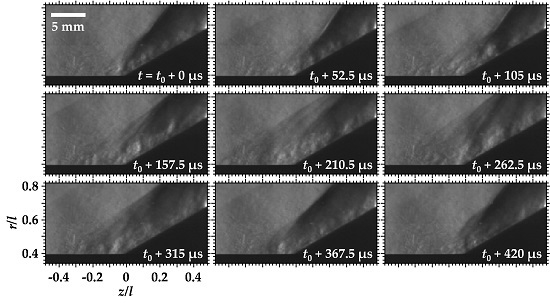Suppression of Low-Frequency Shock Oscillations over Boundary Layers by Repetitive Laser Pulse Energy Deposition
Abstract
:1. Introduction
2. Experimental Apparatus and Methodology
3. Types of Low Frequency Oscillation and the Impact of Energy Deposition
3.1. Weak Flare Fluctuation
3.2. Long Interaction Region
4. The Effect of Pulse Energy
5. Conclusions
Supplementary Materials
Acknowledgments
Author Contributions
Conflicts of Interest
Abbreviations
| SWBLI | Shock-wave boundary-layer interaction |
References
- Clemens, N.T.; Narayanaswamy, V. Low-Frequency Unsteadiness of Shock Wave/Turbulent Boundary Layer Interactions. Annu. Rev. Fluid Mech. 2014, 46, 469–492. [Google Scholar] [CrossRef]
- Ganapathisubramani, B.; Clemens, N.T.; Dolling, D.S. Effects of upstream boundary layer on the unsteadiness of shock-induced separation. J. Fluid Mech. 2007, 585, 369–394. [Google Scholar] [CrossRef]
- Ganapathisubramani, B.; Clemens, N.T.; Dolling, D.S.; Road, P.C. Low-frequency dynamics of shock-induced separation in a compression ramp interaction. J. Fluid Mech. 2009, 636, 397–425. [Google Scholar] [CrossRef]
- Andreopoulos, J.; Muck, K.C. Some new aspects of the shock-wave/boundary-layer interaction in compression-ramp flows. J. Fluid Mech. 1987, 180, 405. [Google Scholar] [CrossRef]
- Dussauge, J.-P.; Dupont, P.; Debieve, J.-F. Unsteadiness in shock wave boundary layer interactions with separation. Aerosp. Sci. Technol. 2006, 10, 85–91. [Google Scholar] [CrossRef]
- Dussauge, J.P.; Piponniau, S. Shock/boundary-layer interactions: Possible sources of unsteadiness. J. Fluids Struct. 2008, 24, 1166–1175. [Google Scholar] [CrossRef]
- Souverein, L.J.; Dupont, P.; Debiève, J.-F.; van Oudheusden, B.W.; Scarano, F.; Debieve, J.-F.; van Oudheusden, B.W.; Scarano, F. Effect of Interaction Strength on Unsteadiness in Shock-Wave-Induced Separations. AIAA J. 2010, 48, 1480–1493. [Google Scholar] [CrossRef]
- Panaras, A.G. Review of the physics of swept-shock/boundary layer interactions. Prog. Aerosp. Sci. 1996, 32, 173–244. [Google Scholar] [CrossRef]
- Dolling, D.S. Fifty years of shock-wave/boundary-layer interaction research: What next? AIAA J. 2001, 39, 1517–1531. [Google Scholar] [CrossRef]
- McCormick, D.C. Shock/boundary-layer interaction control with vortex generators and passive cavity. AIAA J. 1993, 31, 91–96. [Google Scholar] [CrossRef]
- Barter, J.W.; Dolling, D.S. Reduction of fluctuating pressure loads in shock/boundary-layer interactions using vortex generators. AIAA J. 1995, 33, 1842–1849. [Google Scholar] [CrossRef]
- Barter, J.W.; Dolling, D.S. Reduction of fluctuating pressure loads in shock/boundary-layer interactions using vortex generators. II. AIAA J. 1996, 34, 195–197. [Google Scholar] [CrossRef]
- Titchener, N.; Babinsky, H. Shock Wave/Boundary-Layer Interaction Control Using a Combination of Vortex Generators and Bleed. AIAA J. 2013, 51, 1221–1233. [Google Scholar] [CrossRef]
- Saad, M.R.; Zare-Behtash, H.; Che-Idris, A.; Kontis, K. Micro-ramps for hypersonic flow control. Micromachines 2012, 3, 364–378. [Google Scholar] [CrossRef]
- Kontis, K. Flow control effectiveness of jets, strakes, and flares at hypersonic speeds. Proc. Inst. Mech. Eng. Part G J. Aerosp. Eng. 2008, 222, 585–603. [Google Scholar] [CrossRef]
- Osuka, T.; Erdem, E.; Hasegawa, N.; Majima, R.; Tamba, T.; Yokota, S.; Sasoh, A.; Kontis, K. Laser energy deposition effectiveness on shock-wave boundary-layer interactions over cylinder-flare combinations. Phys. Fluids 2014, 26, 096103. [Google Scholar] [CrossRef]
- Tamba, T.; Pham, H.S.; Shoda, T.; Iwakawa, A.; Sasoh, A. Frequency modulation in shock wave-boundary layer interaction by repetitive-pulse laser energy deposition. Phys. Fluids 2015, 27, 091704. [Google Scholar] [CrossRef]
- Kontis, K. Jet Control Effectiveness Studies on a Flat-Plate Body at Hypersonic Speeds. Trans. Jpn. Soc. Aero. Space Sci. 2004, 47, 131–137. [Google Scholar] [CrossRef]
- Erdem, E.; Kontis, K. Numerical and experimental investigation of transverse injection flows. Shock Waves 2010, 20, 103–118. [Google Scholar] [CrossRef]
- Feszty, D.; Badcock, K.J.; Richards, B.E. Driving Mechanisms of High-Speed Unsteady Spiked Body Flows, Part 1: Pulsation Mode. AIAA J. 2004, 42, 95–106. [Google Scholar] [CrossRef]














| Type | l (mm) | θ (°) |
|---|---|---|
| Nominal | 20 | 30 |
| Shallow | 20 | 24 |
| Long | 25 | 30 |
© 2016 by the authors; licensee MDPI, Basel, Switzerland. This article is an open access article distributed under the terms and conditions of the Creative Commons Attribution (CC-BY) license (http://creativecommons.org/licenses/by/4.0/).
Share and Cite
Iwakawa, A.; Shoda, T.; Pham, H.S.; Tamba, T.; Sasoh, A. Suppression of Low-Frequency Shock Oscillations over Boundary Layers by Repetitive Laser Pulse Energy Deposition. Aerospace 2016, 3, 13. https://doi.org/10.3390/aerospace3020013
Iwakawa A, Shoda T, Pham HS, Tamba T, Sasoh A. Suppression of Low-Frequency Shock Oscillations over Boundary Layers by Repetitive Laser Pulse Energy Deposition. Aerospace. 2016; 3(2):13. https://doi.org/10.3390/aerospace3020013
Chicago/Turabian StyleIwakawa, Akira, Tatsuro Shoda, Hoang Son Pham, Takahiro Tamba, and Akihiro Sasoh. 2016. "Suppression of Low-Frequency Shock Oscillations over Boundary Layers by Repetitive Laser Pulse Energy Deposition" Aerospace 3, no. 2: 13. https://doi.org/10.3390/aerospace3020013
APA StyleIwakawa, A., Shoda, T., Pham, H. S., Tamba, T., & Sasoh, A. (2016). Suppression of Low-Frequency Shock Oscillations over Boundary Layers by Repetitive Laser Pulse Energy Deposition. Aerospace, 3(2), 13. https://doi.org/10.3390/aerospace3020013







